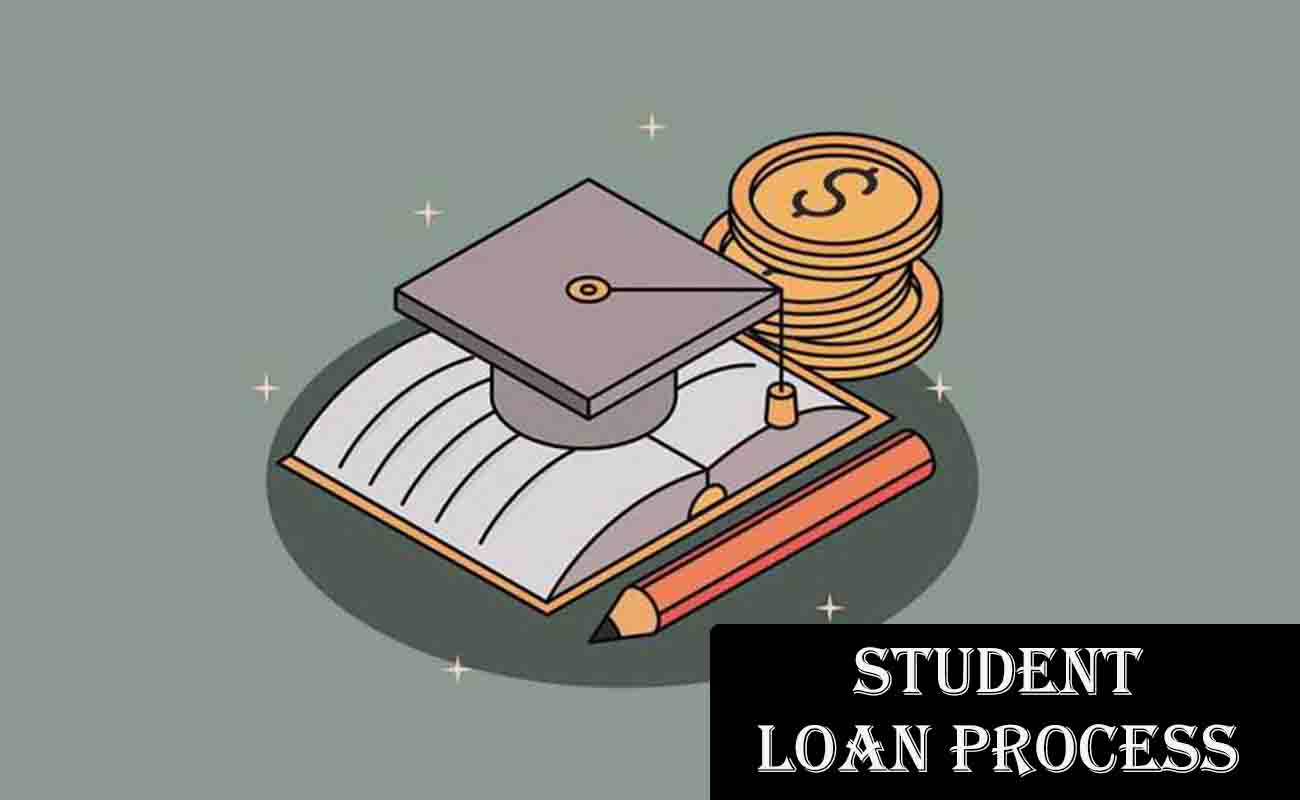The student loan process can seem like a lot to take in, but once you know the basics, it’s manageable. A student loan is money you borrow to pay for your college education, and you have to pay it back with interest after you graduate or leave school. It’s important to understand this process because it can shape your financial future.

In this article, I’m going to walk you through everything you need to know about the student loan process. We’ll cover what student loans are, the different types available, how to apply for them, what interest rates mean, and how to manage them once you have them. By the end, you’ll feel more confident about making decisions regarding your student loans.
What is the Student Loan Process?
The student loan process is the journey you take to borrow money for your education and then repay it over time. It starts with understanding your financial needs, applying for loans, and continues through managing and repaying them.
Whether you’re a high school senior preparing for college or a current student exploring your options, knowing how this process works is crucial. It involves federal and private loans, each with its own rules, benefits, and challenges. Don’t worry—I’ll break it all down for you step by step.
What is a Student Loan?
Let’s start with the basics. A student loan is money you borrow to pay for your education. Unlike scholarships or grants, which you don’t have to pay back, loans need to be repaid with interest. Interest is the extra money you pay on top of the amount you borrowed, and it’s how lenders make money.
There are two main types of student loans: federal and private. Federal loans are provided by the government, specifically the U.S. Department of Education, and they usually have lower interest rates and more flexible repayment options.
Private loans, on the other hand, are offered by banks, credit unions, and other financial institutions, and they might require a cosigner, especially if you don’t have a strong credit history. Why might you need a student loan? College can be expensive. Tuition, room and board, books, supplies, and even transportation can add up quickly.
For many students, loans are a way to bridge the gap between what they can afford and the total cost of their education. It’s important to borrow only what you need and to understand the terms of your loans, as they’ll impact your finances long after you graduate.
How to Apply for a Student Loan
Now, let’s talk about how to apply for these loans. If you’re interested in federal loans, the first step is to fill out the Free Application for Federal Student Aid (FAFSA) at FAFSA website. The FAFSA determines your eligibility for federal student aid, including loans, grants, and work-study programs.
It asks about your family’s income, assets, and other financial details to calculate how much aid you might qualify for. Once you submit your FAFSA, your school will send you a financial aid offer, which might include federal loans. You’ll then need to sign a Master Promissory Note (MPN), which is a legal document agreeing to repay the loan.
For private loans, the process is different. You’ll need to apply directly with a lender, such as a bank or an online lender. They’ll usually check your credit score, and if you’re a student without much credit history, you might need a cosigner, like a parent or guardian, to guarantee the loan.
Private loans can be a good option if you’ve maxed out your federal loan limits or need extra funding, but they often come with higher interest rates and fewer protections.
Here’s a quick comparison of the application processes:
| Loan Type | Application Process | Key Requirements |
|---|---|---|
| Federal Loans | Submit FAFSA, accept financial aid offer, sign MPN | Financial information, enrollment in eligible program |
| Private Loans | Apply directly with lender, credit check | Good credit or cosigner, proof of enrollment |
Types of Student Loans
Let’s dive deeper into the types of student loans available.
Federal Student Loans
Federal loans are the first option you should consider because they usually have lower interest rates and more borrower-friendly terms. Here are the main types:
- Direct Subsidized Loans: These are for undergraduate students with financial need. The government pays the interest on these loans while you’re in school at least half-time and during a six-month grace period after you leave school.
- Direct Unsubsidized Loans: These are available to both undergraduate and graduate students, regardless of financial need. Interest starts accruing from the moment the loan is disbursed, so you might want to make payments while in school to avoid a larger balance later.
- Direct PLUS Loans: These are for graduate students and parents of dependent undergraduate students. They have higher interest rates and fees compared to other federal loans, but they can help cover costs that other loans don’t.
- Direct Consolidation Loans: These allow you to combine multiple federal student loans into one loan with a single monthly payment. It can simplify repayment but doesn’t reduce your total interest.
Private Student Loans
Private loans are not standardized like federal loans. Each lender has its own terms, interest rates, and requirements. Some private loans might offer variable interest rates, which can change over time, while others have fixed rates. Private loans can be a good option if you’ve exhausted your federal aid, but they often require good credit or a cosigner, and they don’t offer the same protections as federal loans, like income-driven repayment plans.
Here’s a table summarizing the key differences:
| Feature | Federal Loans | Private Loans |
|---|---|---|
| Interest Rates | Fixed, generally lower (e.g., 6.39% for undergrad in 2025-2026) | Fixed or variable, often higher |
| Repayment Options | Flexible, including income-driven plans | Varies by lender, less flexible |
| Borrower Protections | Forgiveness, deferment, forbearance | Limited, depends on lender |
| Eligibility | Based on FAFSA, no credit check for most | Credit check, may need cosigner |
Interest Rates and Repayment Plans
Interest rates are a crucial part of understanding student loans. For the 2025-2026 academic year, the interest rates for federal loans are:
- Direct Subsidized and Unsubsidized Loans for undergraduates: 6.39%
- Direct Unsubsidized Loans for graduate students: 7.94%
- Direct PLUS Loans: 8.94%
Private loan interest rates can vary widely depending on the lender and your creditworthiness. They might be higher than federal rates, especially if you have a cosigner with poor credit. Fixed rates stay the same over the life of the loan, while variable rates can fluctuate, potentially increasing your payments.
When it comes to repaying your loans, federal loans offer several repayment plans:
- Standard Repayment Plan: Fixed payments over 10 years.
- Income-Driven Repayment Plans: Payments based on your income, with forgiveness after 20 or 25 years. For example, the SAVE Plan adjusts payments to 5-20% of your discretionary income.
- Graduated Repayment Plan: Payments start low and increase over time, typically over 10 years.
- Extended Repayment Plan: Payments stretched over 25 years, with higher total interest.
Private loans typically have their own repayment terms, which might start while you’re still in school or after a grace period. Some private lenders offer deferment options, but interest might still accrue during that time.
For example, if you borrow $10,000 in a Direct Subsidized Loan at 6.39% with a 1.057% origination fee, you’ll pay about $13,703 over 10 years. A private loan at 9.49% with no origination fee could cost you $15,521 over the same period, according to calculations from Saving for College.
Managing Your Student Loans
Once you have your student loans, it’s important to manage them wisely. Here are some tips to help you stay on top of things:
- Make payments on time: This helps you avoid late fees and protects your credit score.
- Consider making extra payments: Paying more than the minimum can reduce the principal and save you money on interest over time.
- Set up automatic payments: Many lenders offer a small interest rate discount for automatic payments.
- Understand your loan servicer: Your servicer is the company that handles your loan payments and provides customer service. Know who they are and how to contact them.
- Keep track of your loan balance: Regularly check your statements to ensure there are no errors.
- If you’re struggling, ask for help: Contact your loan servicer to discuss options like deferment or forbearance if you’re having trouble making payments.
It’s also worth noting that refinancing your loans can sometimes lower your interest rate, but be careful—refinancing federal loans into private loans means losing federal benefits like income-driven repayment plans or potential loan forgiveness. If you’re considering refinancing, check out options at Best Student Loan Refinance Companies.
If you miss payments, your loan could go into default, which can hurt your credit and lead to serious consequences like wage garnishment. If you’re struggling, reach out to your servicer early to explore your options.
FAQs
Let’s address some common questions about the student loan process:
- What happens to my student loans if I die?
For federal loans, they may be discharged upon your death, meaning your estate or cosigner isn’t responsible. For private loans, it depends on the lender—some may forgive the loan, while others may require a cosigner to pay. - How long does it take to pay off student loans?
It can take anywhere from 5 to 30 years, depending on the repayment plan. The standard federal plan is 10 years, but income-driven plans can extend to 20 or 25 years. - How do student loans affect my credit?
Making timely payments can improve your credit score, while missing payments or defaulting can harm it. Defaulting can lead to serious consequences, like wage garnishment or loss of tax refunds. - Can I get a student loan without my parents’ help?
Yes, you can apply for federal loans as an independent student through the FAFSA. For private loans, you might need a cosigner or explore other options like installment plans. Learn more at Getting a Student Loan Without Parental Help.
Key Citations
- How Do Student Loans Work? Federal vs. Private, Interest Rates
- Federal Student Aid: Types of Loans
- Fidelity: How Do Student Loans Work?
- What is the FAFSA?
- Complete Guide to Cosigning Student Loans
- Best Private Student Loans for College
- Student Loan Forgiveness for Teachers
- Which Jobs Qualify for Public Service Loan Forgiveness
- What is a Subsidized Student Loan?
- Everything You Need to Know About the Federal PLUS Loan
- Pros and Cons of Federal Student Loan Consolidation
- Federal Student Loan Limits
- Annual and Aggregate Student Loan Limits
- Loan Calculator
- What is a Master Promissory Note?
- The Complete Guide to Applying for Student Loans
- SAVE Repayment Plan for Student Loans
- Best Student Loan Refinance Companies
- How to Get a Student Loan Without Parental Help
